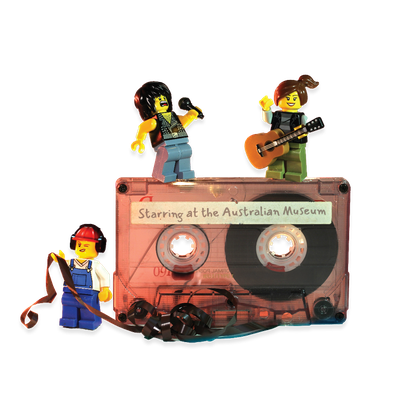Your search returned 12438 results
By Page Type
By Tag
- fish (966)
- blog (696)
- fishes of sydney harbour (401)
- First Nations (298)
- Blog (236)
- AMRI (169)
- archives (164)
- Eureka Prizes (146)
- Aboriginal and Torres Strait Islander (135)
- insect (126)
- Ichthyology (124)
- geoscience (109)
- minerals (102)
- climate change (99)
- podcast (94)
- Fish (91)
- Anthropology (89)
- International collections (80)
- Minerals Gallery (78)
- wildlife of sydney (78)
- Labridae (77)
- frog (74)
- gemstone (70)
- photography (66)
- history (63)
- Mollusca (60)
- gem (59)
- staff (59)
- Birds (56)
- Gems (56)
- Indonesia (56)
- education (55)
- shark (55)
- AMplify (54)
- people (53)
- earth sciences (50)
- exhibition (50)
- past exhibitions (50)
- Gobiidae (48)
- sustainability (46)
- Pomacentridae (45)
- Serranidae (44)
- lifelong learning (42)
- science (42)
- Earth and Environmental Science (41)
- Syngnathidae (41)
- Ancient Egypt (40)
- Bali (40)
- bird (40)
- dangerous australians (40)
-
Diversity of Cryptosporidium in brush-tailed rock-wallabies (Petrogale penicillata) managed within a species recovery programme
https://publications.australian.museum/diversity-of-cryptosporidium-in-brush-tailed-rock-wallabies-petrogale-penicillata-managed-within-a-species-recovery-programme/Diversity of Cryptosporidium in brush-tailed rock-wallabies (Petrogale penicillata) managed within a species recovery programme
-
Development of 16 forensically informative microsatellite loci to detect the illegal trade of broad headed snakes (Hoplocephalus bungaroides).
https://publications.australian.museum/development-of-16-forensically-informative-microsatellite-loci-to-detect-the-illegal-trade-of-broad-headed-snakes-hoplocephalus-bungaroides/Development of 16 forensically informative microsatellite loci to detect the illegal trade of broad headed snakes (Hoplocephalus bungaroides).
-
Reproductive success and pollination of the Tuncurry Midge Orchid (Genoplesium littorale) (Orchidaceae) by chloropid flies
https://publications.australian.museum/reproductive-success-and-pollination-of-the-tuncurry-midge-orchid-genoplesium-littorale-orchidaceae-by-chloropid-flies/Reproductive success and pollination of the Tuncurry Midge Orchid (Genoplesium littorale) (Orchidaceae) by chloropid flies
-
A new species of Near-shore Marine Goby (Pisces: Gobiidae: Nesogobius) from Kangaroo Island, Australia
https://publications.australian.museum/a-new-species-of-near-shore-marine-goby-pisces-gobiidae-nesogobius-from-kangaroo-island-australia/A new species of Near-shore Marine Goby (Pisces: Gobiidae: Nesogobius) from Kangaroo Island, Australia
-
Australo-Papuan treecreepers (Passeriformes: Climacteridae) and a new species of sittella (Neosittidae: Daphoenositta) from the Miocene of Australia
https://publications.australian.museum/australo-papuan-treecreepers-passeriformes-climacteridae-and-a-new-species-of-sittella-neosittidae-daphoenositta-from-the-miocene-of-australia/Australo-Papuan treecreepers (Passeriformes: Climacteridae) and a new species of sittella (Neosittidae: Daphoenositta) from the Miocene of Australia
-
Gene flow despite complex Robertsonian fusions amongst rock-wallaby (Petrogale) species
https://publications.australian.museum/gene-flow-despite-complex-robertsonian-fusions-amongst-rock-wallaby-petrogale-species/Gene flow despite complex Robertsonian fusions amongst rock-wallaby (Petrogale) species
-
A new species of pencil smelt Nansenia boreacrassicauda (Microstomatidae, Argentiniformes) from the North Atlantic Ocean
https://publications.australian.museum/a-new-species-of-pencil-smelt-nansenia-boreacrassicauda-microstomatidae-argentiniformes-from-the-north-atlantic-ocean/A new species of pencil smelt Nansenia boreacrassicauda (Microstomatidae, Argentiniformes) from the North Atlantic Ocean
-
Recent collections of fishes at the Kermadec Islands and new records for the region
https://publications.australian.museum/recent-collections-of-fishes-at-the-kermadec-islands-and-new-records-for-the-region/Recent collections of fishes at the Kermadec Islands and new records for the region
-
Description of Nassarius berniceae (Mollusca: Gastropoda: Nassariidae): a new species.
https://publications.australian.museum/description-of-nassarius-berniceae-mollusca-gastropoda-nassariidae-a-new-species/Description of Nassarius berniceae (Mollusca: Gastropoda: Nassariidae): a new species.
-
Selecting potential non-target species for host range testing for Eadya Paropsidis
https://publications.australian.museum/selecting-potential-non-target-species-for-host-range-testing-for-eadya-paropsidis/Selecting potential non-target species for host range testing for Eadya Paropsidis
-
Discover more
2025 Australian Geographic Nature Photographer of the Year
Special exhibition
Free entry
Now open -
Discover more
Unfinished Business
Special exhibition
Free entry
Now open -
Discover more
Wansolmoana
Permanent exhibition
Free entry
Open daily -
Find out more
Burra
Permanent kids learning space
Free entry
10am - 4.30pm![]()
-
Discover more
Minerals
Permanent exhibition
Free entry
Open daily![]()




